Organic Sourdough Bread is a delightful recipe that brings the rustic charm of homemade baking right to your kitchen. This fluffy, artisanal loaf can be made with just a few basic ingredients and takes around 24 hours from start to finish, including fermentation. With its tangy flavor and chewy crust, Organic Sourdough Bread is sure to impress your family and friends.
I still remember the first time I baked Organic Sourdough Bread with my mom Julia in our cozy California kitchen. The aroma of warm bread filled our home, creating memories I cherish to this day. Every Saturday, I now pass this tradition to my daughters, often pairing it with a warm bowl of homemade tomato soup for a perfect comfort meal. If you’re looking for a variation, you might also enjoy our Gluten Free Sourdough Bread—a wholesome option that doesn’t compromise on flavor.
PrintOrganic Sourdough Bread
Discover the delicious world of Organic Sourdough Bread! Perfect for those who love fresh, homemade goodness. This recipe captures the true essence of sourdough with all-natural ingredients, providing a delightful and rich taste. Whether you are a seasoned baker or a novice, our step-by-step guide will make baking this classic bread easy and enjoyable. Click to explore the full recipe and bring the wholesome flavor of organic sourdough to your kitchen today!
- Prep Time: 13 hours
- Cook Time: 1 hour
- Total Time: 14 hours
- Yield: 1 loaf 1x
- Category: Sourdough Bread Recipes
- Method: Baking
- Cuisine: American
Ingredients
- 150g / 5.35 oz bubbly, active sourdough starter
- 250g / 8.80 oz warm water, preferably filtered (see notes below)
- 25g / .90 oz olive oil
- 500g / 17.65 oz bread flour (not all purpose flour)
- 10g / .4 oz fine sea salt
- Fine ground cornmeal or parchment paper
Instructions
Step 1: Prepare Your Starter
Begin with a healthy sourdough starter. If it’s been refrigerated, feed it at least a few hours before you plan to bake, allowing it to become bubbly and active.
Step 2: Mix the Dough
In a large mixing bowl, combine your active starter with flour and water. Stir until there are no dry bits of flour left. This initial mix will create a shaggy dough.
Step 3: Autolyse
Let the dough rest for about 30 minutes. This process, known as autolyse, allows the flour to fully hydrate and helps develop gluten.
Step 4: Add Salt
After the autolyse, sprinkle salt over your dough. Incorporate the salt by kneading gently; this helps to strengthen the dough.
Step 5: Bulk Fermentation
Cover the bowl and let it rise at room temperature for several hours. During this time, perform stretch and folds every 30 minutes to build the dough’s strength.
Step 6: Shape the Dough
Once the dough has doubled in size, turn it out onto a floured surface. Gently shape it into a round loaf without deflating too much of the air.
Step 7: Proofing
Let the shaped dough rise in a proofing basket or bowl lined with a kitchen towel for about 1-2 hours until it becomes puffy.
Step 8: Preheat the Oven
About 30 minutes before baking, preheat your oven to 450°F 232°C with a Dutch oven inside. This ensures a hot environment for the bread to bake perfectly.
Step 9: Bake the Bread
Carefully place the dough into the hot Dutch oven, cover it, and bake for 30 minutes. After that, remove the lid and bake for an additional 15-20 minutes until it’s golden brown.
Step 10: Cool the Bread
Once baked, remove the bread from the oven and let it cool on a wire rack for at least an hour before slicing. This allows the crumb to set properly.
Notes
Tip 1: Use Quality Ingredients
- The flavor of your Organic Sourdough Bread will rely heavily on the quality of your flour and water so choose raw organic options if possible.
Tip 2: Check the Hydration Level
- Depending on the type of flour you use you may need to adjust the water content for the dough to maintain the right consistency.
Tip 3: Pay Attention to the Temperature
- Baking bread in a too-cool environment can result in less rise. Ideal fermentation occurs between 75°F and 80°F 24°C to 27°C.
Nutrition
- Serving Size: 12
- Calories: 1480kcal
- Fat: 25g
Why you’ll love Organic Sourdough Bread
- Flavorful Bliss: The delightful tang and rich aroma make every slice a delicious experience that brightens your day.
- Perfect Texture: With a crispy crust and chewy interior, each bite is an enjoyable contrast that excites your palate.
- Simple Ingredients: Using only organic flour and water, this recipe champions wholesome goodness you can feel good about.
- Easy to Make: With minimal effort, you’ll create a beautiful loaf, perfect for sandwiches or enjoying with soup.

Step-by-Step Cooking Instructions
- Step 1: Prepare Your Starter
Begin with a healthy sourdough starter. If it’s been refrigerated, feed it at least a few hours before you plan to bake, allowing it to become bubbly and active. - Step 2: Mix the Dough
In a large mixing bowl, combine your active starter with flour and water. Stir until there are no dry bits of flour left. This initial mix will create a shaggy dough. - Step 3: Autolyse
Let the dough rest for about 30 minutes. This process, known as autolyse, allows the flour to fully hydrate and helps develop gluten. - Step 4: Add Salt
After the autolyse, sprinkle salt over your dough. Incorporate the salt by kneading gently; this helps to strengthen the dough. - Step 5: Bulk Fermentation
Cover the bowl and let it rise at room temperature for several hours. During this time, perform stretch and folds every 30 minutes to build the dough’s strength. - Step 6: Shape the Dough
Once the dough has doubled in size, turn it out onto a floured surface. Gently shape it into a round loaf without deflating too much of the air. - Step 7: Proofing
Let the shaped dough rise in a proofing basket or bowl lined with a kitchen towel for about 1-2 hours until it becomes puffy. - Step 8: Preheat the Oven
About 30 minutes before baking, preheat your oven to 450°F (232°C) with a Dutch oven inside. This ensures a hot environment for the bread to bake perfectly. - Step 9: Bake the Bread
Carefully place the dough into the hot Dutch oven, cover it, and bake for 30 minutes. After that, remove the lid and bake for an additional 15-20 minutes until it’s golden brown. - Step 10: Cool the Bread
Once baked, remove the bread from the oven and let it cool on a wire rack for at least an hour before slicing. This allows the crumb to set properly.
Notes
- Tip 1: Use Quality Ingredients
The flavor of your Organic Sourdough Bread will rely heavily on the quality of your flour and water, so choose raw, organic options if possible. - Tip 2: Check the Hydration Level
Depending on the type of flour you use, you may need to adjust the water content for the dough to maintain the right consistency. - Tip 3: Pay Attention to the Temperature
Baking bread in a too-cool environment can result in less rise. Ideal fermentation occurs between 75°F and 80°F (24°C to 27°C).
Organic Sourdough Bread – A Closer Look
The process of making Organic Sourdough Bread is as much an art as it is a science. What makes it unique is the balance of tangy flavor from the natural fermentation combined with the crispy crust and soft, airy crumb inside. Each loaf tells a story of time, patience, and the wild yeast from your surroundings. It’s more than just a recipe; it’s a beautiful expression of creativity and local ingredients.
Bringing It to Your Kitchen
Picture a cozy weekend afternoon spent with family, the aroma of freshly baked Organic Sourdough Bread filling your home. This recipe is perfect for gatherings or as an accompaniment to a hearty soup or salad. Invite friends over for a casual brunch where homemade bread is the star, or toast a slice for breakfast with a spread of avocado and a sprinkle of salt. Each bite is an experience to enjoy and share.
Common Mistakes to Avoid
One common mistake is not allowing your dough enough time to rise during bulk fermentation, which can lead to dense bread. Monitor the fermentation times closely; patience is key to achieving that airy structure. Additionally, many overlook the importance of preheating their baking vessel, which is crucial for getting that oven spring that makes sourdough so delightful. Always ensure your ingredients are measured accurately, especially when working with hydration levels.
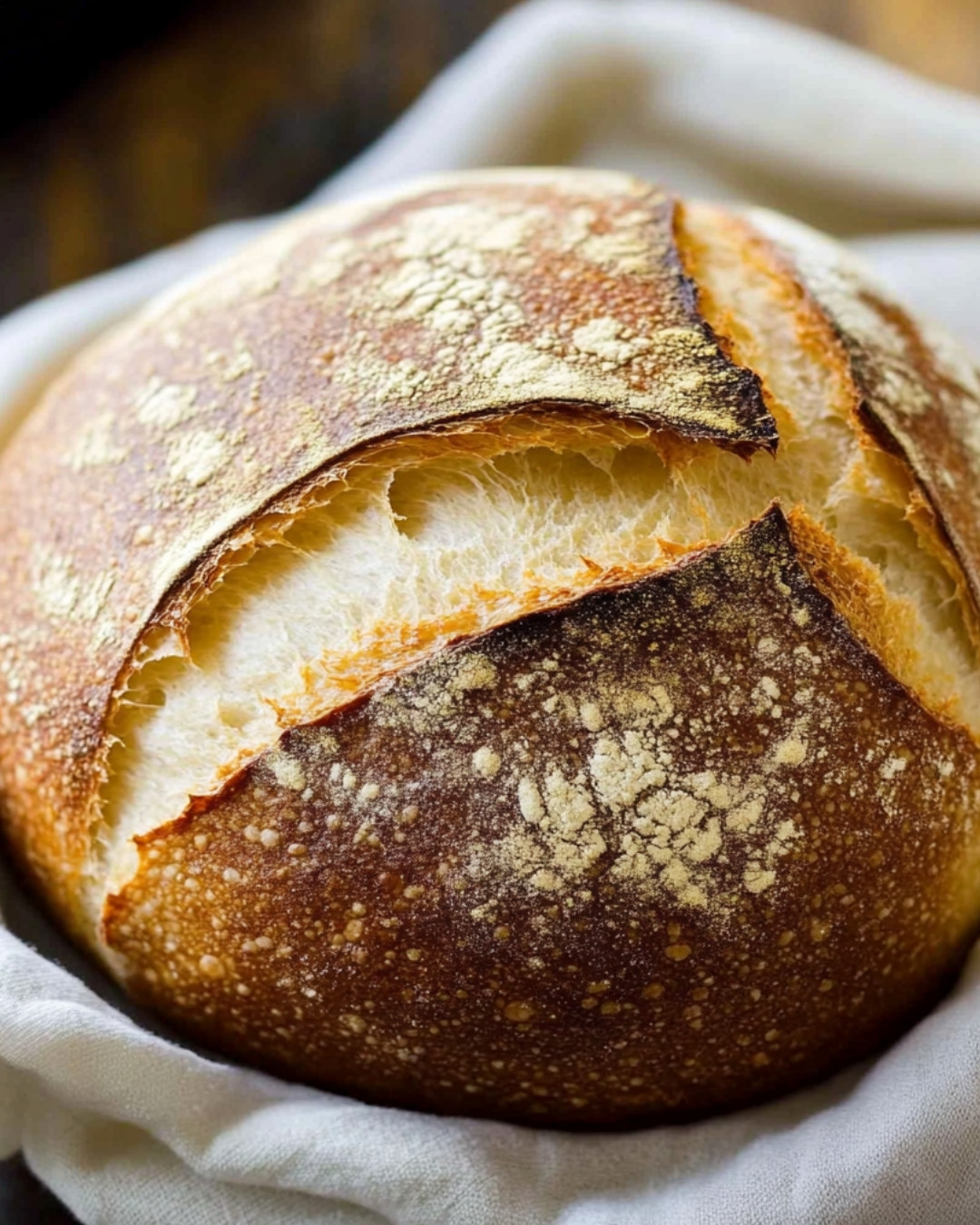
Cook Techniques
Preparing the Starter
To make organic sourdough bread, begin by preparing your starter. Mix equal parts of organic flour and water in a jar, about 100g of each. Stir well, cover with a cloth, and let it sit at room temperature. This mix will ferment for 5-7 days, bubbling and rising. You’ll know it’s ready when it doubles in size and has a tangy aroma.
Kneading the Dough
Once your starter is active, mix it with additional organic flour and water to form a dough. Knead for about 10 to 15 minutes until the dough feels smooth and elastic. This step is critical; you should feel a soft, slightly tacky texture just before it starts to pull away from your hands.
Fermentation
Transfer your dough to a lightly floured bowl, cover it, and let it ferment. Depending on your room temperature, this will take 4-6 hours. Look for it to rise significantly and develop bubbles on the surface. This indicates that the yeast is busy creating that delightful sour flavor.
Shaping the Loaf
After fermentation, gently punch down the dough to release the gas. Shape it into a round loaf by folding the edges into the center. This creates surface tension, which will help achieve a lovely dome as it bakes.
Baking
Preheat your oven to 450°F (230°C). Place your loaf on a pre-heated baking stone or a baking sheet. Bake for 30-40 minutes until you achieve a golden-brown crust. The loaf should sound hollow when tapped on the bottom. You’ll know your organic sourdough bread is ready when it has a crusty outside and a soft, airy inside.
Serving and Presentation Ideas
Classic Slices with Butter
Serve your organic sourdough bread simply with a generous pat of salted butter. For a pop of color and flavor, sprinkle fresh herbs like chives or parsley on top. Arrange slices on a rustic wooden board for a homey feel.
Soup Pairing
Pair your sourdough with a hearty bowl of homemade soup. Consider presenting the bread in a soup bowl as a bread bowl alternative, adding a fun twist! You might also sprinkle a bit of paprika on the soup’s surface for color and depth.
Cheese Board Delight
Create a casual cheese platter featuring different varieties of cheese—sharp cheddar, creamy brie, or tangy goat cheese. Include a small bowl of honey or fig jam for a sweet contrast to the savory bread. Arrange the board artfully with fresh fruits.
Salad Sandwiches
Make mini sandwiches filled with fresh greens, heirloom tomatoes, and a drizzle of balsamic glaze. Cut your bread into fun shapes using cookie cutters for a playful touch. Serve them on a colorful platter to make your meal visually appealing.
For more delicious recipes and cooking inspiration, follow me on Facebook and Pinterest!
Conclusion
Enjoy the delightful crunch and tangy flavor of Organic Sourdough Bread, perfect for weeknights or festive gatherings. This loaf brings warmth and togetherness to any meal, making it a great companion for family dinners and holiday feasts.
The preparation is straightforward and rewarding, filling your kitchen with a delightful aroma. Impress your guests with a restaurant-quality bread that embodies the love and tradition found in each slice—a true hallmark of my personal cooking journey.
People Also Ask :
Can I use organic flour to make sourdough bread?
What is the secret to making good sourdough bread?
Is organic sourdough bread healthy?
What are the ingredients in organic sourdough bread?
FAQ
How long does sourdough bread last?
Can I make sourdough bread without a Dutch oven?
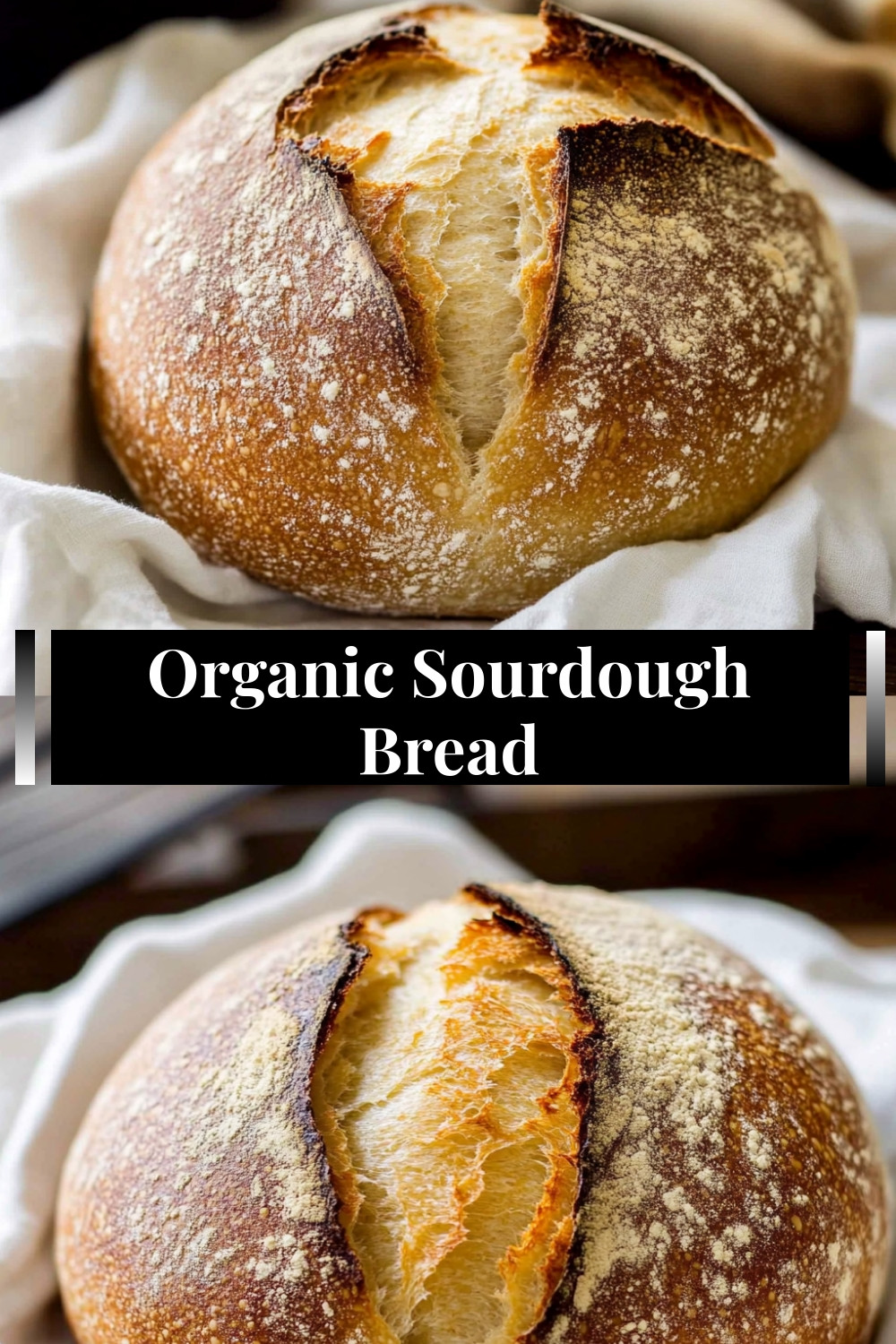

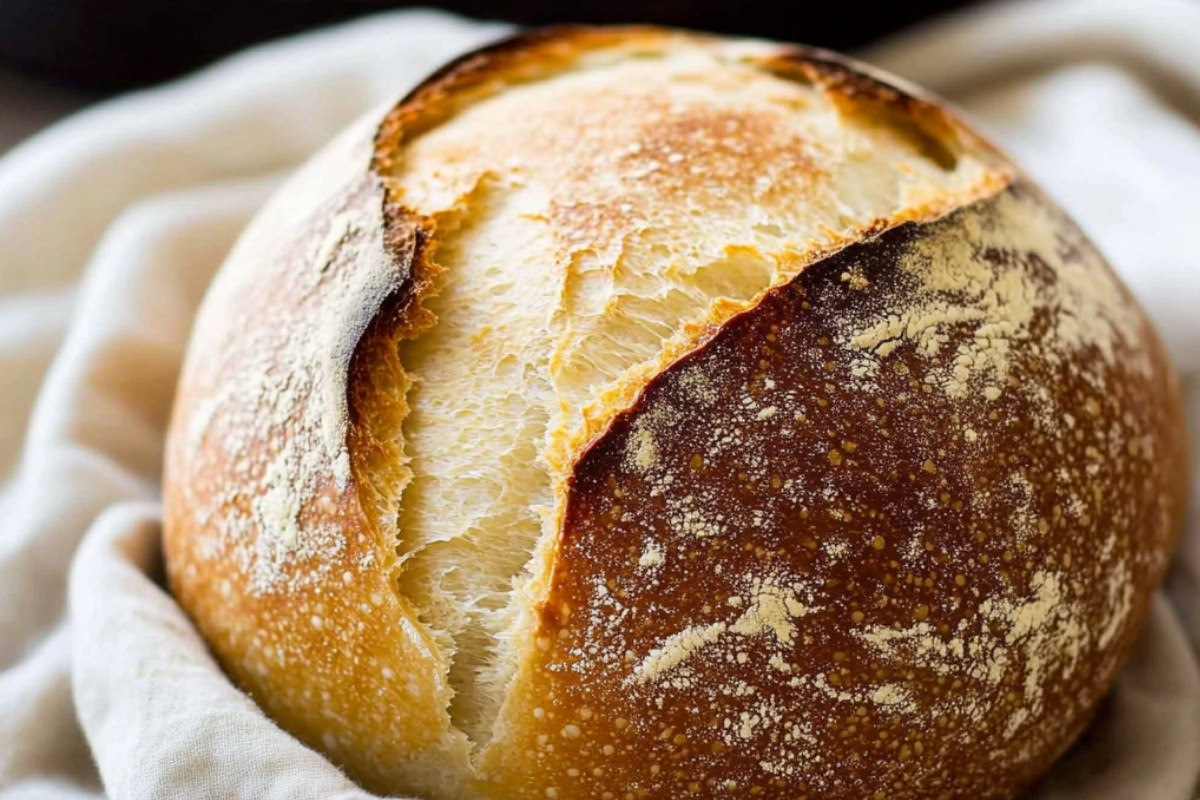





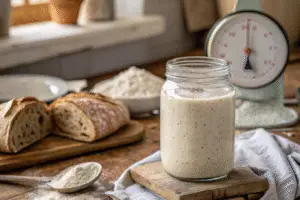


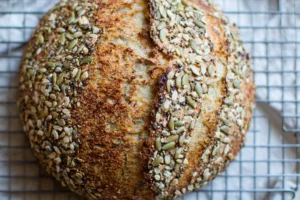

7 thoughts on “Organic Sourdough Bread”
Comments are closed.